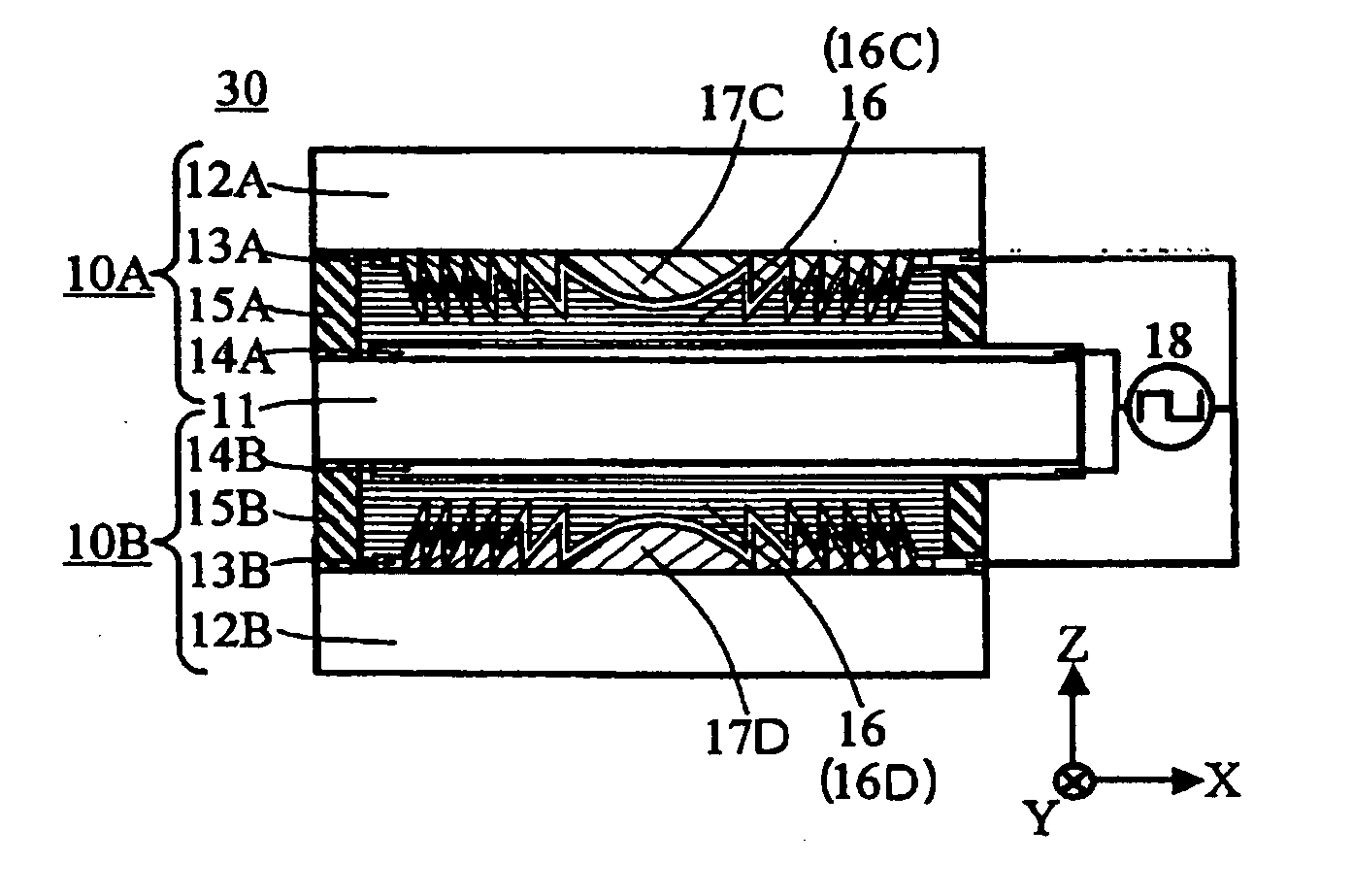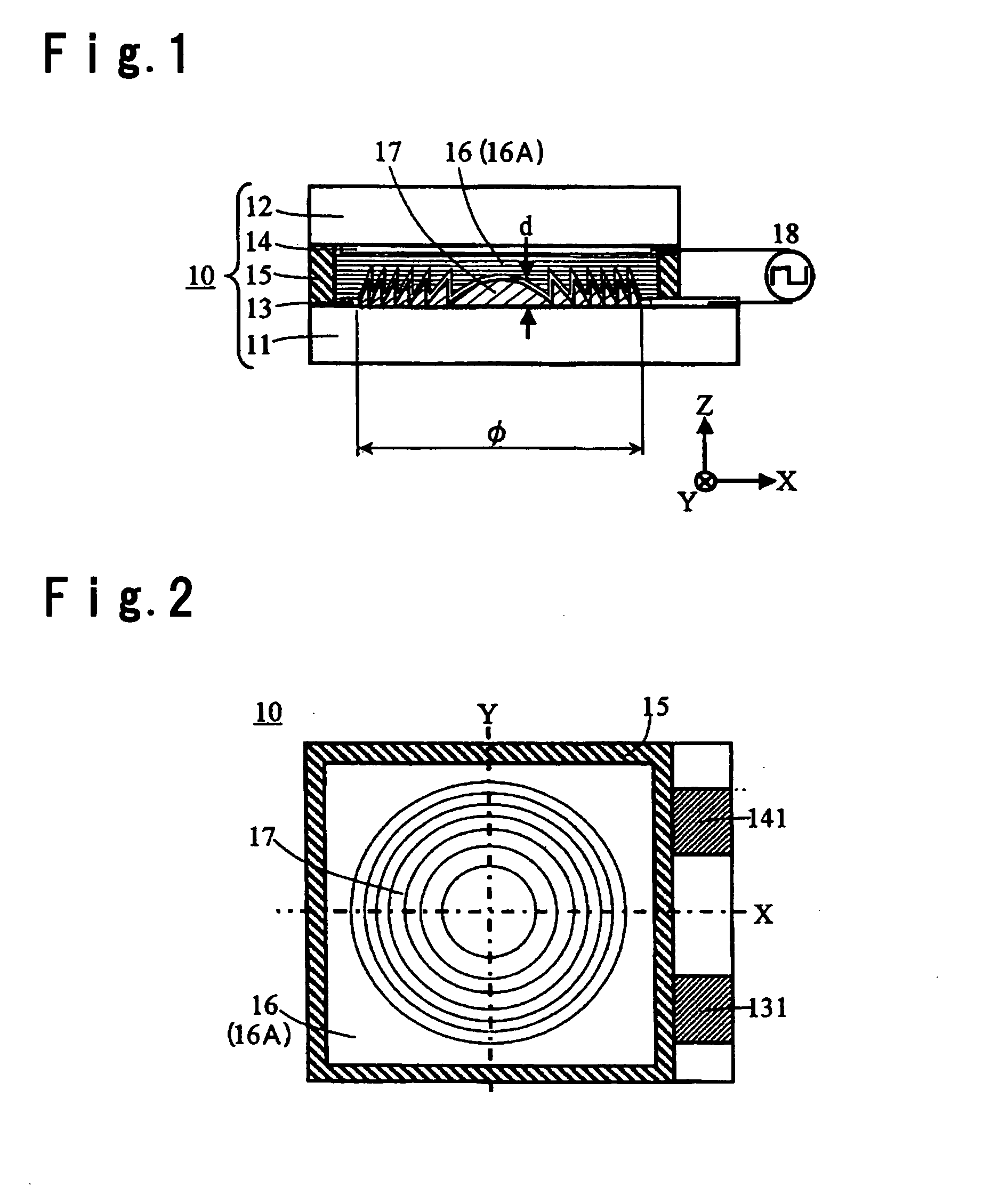Liquid crystal lens element and optical head device
a liquid crystal lens and optical head technology, applied in the field of liquid crystal lens element and optical head device, can solve the problems of deterioration of incident light convergence on information recording layer, writing error, and writing error, and achieve the effects of reducing the thickness of the liquid crystal layer, high speed response, and small siz
- Summary
- Abstract
- Description
- Claims
- Application Information
AI Technical Summary
Benefits of technology
Problems solved by technology
Method used
Image
Examples
first embodiment
[0074] An example of the construction of the liquid crystal lens element 10 according to the first embodiment of the present invention, is described in detail with reference to a side view shown in FIG. 1 and a plan view shown in FIG. 2.
[0075] The liquid crystal lens element 10 of this embodiment comprises transparent substrates 11 and 12, transparent electrodes 13 and 14, a seal 15, a liquid crystal (liquid crystal layer) 16, a concave-convex portion 17 and an AC power source 18.
[0076] Among these, the concave-convex portion 17 has a shape of a Fresnel lens or a Fresnel lens approximated by steps, which is formed by employing a transparent material having a refractive index ns, and has a rotational symmetry about an optical axis (Z axis) of incident light within a region of effective diameter φ.
[0077] Then, an example of production process of the liquid crystal lens element 10, is described as follows.
[0078] First of all, on one of the flat surfaces (a top surface in FIG. 1) of...
second embodiment
[0118] An example of the construction of a liquid crystal lens element 20 according to the second embodiment of the present invention, is described in detail with reference to a side view shown in FIG. 5. Here, in this embodiment, same portions as those of the first embodiment are designated as the same reference numerals to avoid duplication of explanation.
[0119] The liquid crystal lens element 20 of this embodiment is different from the liquid crystal lens element 10 of the first embodiment in that the maximum depth d of a concave-convex portion 17B corresponds to the depth in a case of m=2 of the above-mentioned Formula (2). Accordingly, the distribution of the depth of the liquid crystal layer 16B is also different.
[0120] The concave-convex portion 17B of the liquid crystal lens element 20 according to this embodiment, is described as follows. Here, α of FIG. 6 is, in the same manner as α of FIG. 3, a graph showing an optical path difference OPD represented by Formula (3). Fur...
third embodiment
[0139] Then, the liquid crystal lens element 30 according to the third embodiment of the present invention, is described with reference to FIG. 8. Here, in this embodiment, portions common with those of the first embodiment, are designated by the same reference numerals to avoid duplication of explanation.
[0140] The liquid crystal lens element 30 of this embodiment comprises a first liquid crystal lens element 10A, a second lens element 10B and an AC power source 18 for applying AC voltage to these elements. The combination of the first and second liquid crystal lens elements 10A and 10B, has a construction that two liquid crystal lens elements 10 according to the first embodiment are laminated above and below so that their concave-convex portions 17 are opposed to each other (here, a transparent substrate 11 is shared).
[0141] Here, the first (the second) liquid crystal lens element 10A (10B) comprises a transparent substrate 11 on which a second transparent electrode 14A (14B) is...
PUM
| Property | Measurement | Unit |
|---|---|---|
| wavelength band | aaaaa | aaaaa |
| thickness | aaaaa | aaaaa |
| thicknesses | aaaaa | aaaaa |
Abstract
Description
Claims
Application Information
 Login to View More
Login to View More - R&D
- Intellectual Property
- Life Sciences
- Materials
- Tech Scout
- Unparalleled Data Quality
- Higher Quality Content
- 60% Fewer Hallucinations
Browse by: Latest US Patents, China's latest patents, Technical Efficacy Thesaurus, Application Domain, Technology Topic, Popular Technical Reports.
© 2025 PatSnap. All rights reserved.Legal|Privacy policy|Modern Slavery Act Transparency Statement|Sitemap|About US| Contact US: help@patsnap.com



